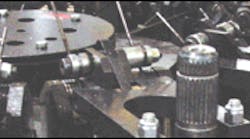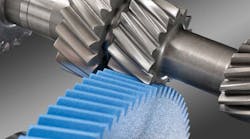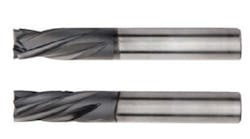Manually inspecting mounting holes on thousands of axle shafts proved slow, unreliable, and tedious for a major Detroit automotive supplier. The shop needed to 100% inspect each hole's location, depth, and thread at a rate of 200 parts/hr/gage so as not to compromise production. For such a demanding task, it relies on the Eagle Thread Verifier (ETV) gaging system. Well-suited for machining lines, the ETV signals production lines to stop if there is a problem. This lets shops make immediate adjustments and corrections to tapping processes or tool replacements.
A PLC that oversees automation moving parts through the gaging system also controls the ETV. Users can incorporate the gage control as a full turnkey system configured and programmed to manage multifunction gaging stations. The control also accepts data through ethernet.
At the automotive supplier's shop, the ETV, in a cycle of only seconds, automatically checks for holes and the thread pitch leads, thread depths, location, and perpendicularity. It also detects untapped holes, broken taps in holes, incorrect pitch diameters, thread starting points, and counterbore depths.
Two six-spindle ETV units replace up to seven technicians using manual thread plugs, allowing shops to assign them to more-productive tasks. Each ETV unit delivers a cycle time of 13 to 25 sec, depending on production requirements.
In operation, a robot unloads a pair of axle shafts from a CNC drill/tap machine and places them on automation leading to a gaging index table where the ETV units check hole positions and their relation to pilot bores. Six gages run simultaneously through the tapped holes as the system monitors torque produced and depth. Such data can be stored or uploaded if required.

Latest from Uncategorized
Latest from Uncategorized
Uncategorized
Newsletter Confirmation Page
Oct. 29, 2012
Uncategorized
Gearmaking with Precision, and Speed
July 26, 2012
Uncategorized
Composites, With No Limits
July 25, 2012




